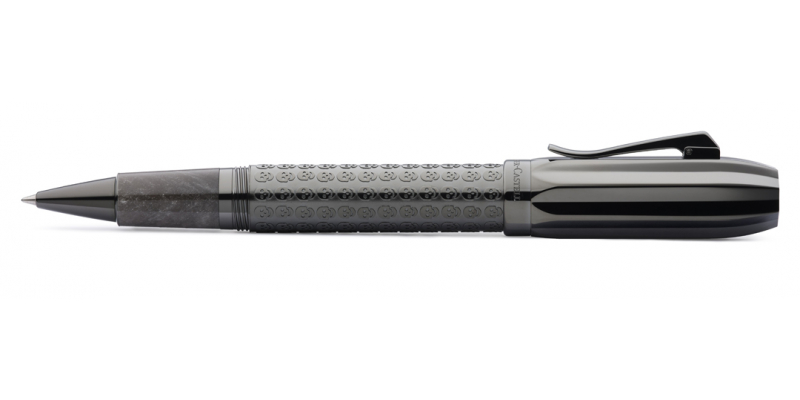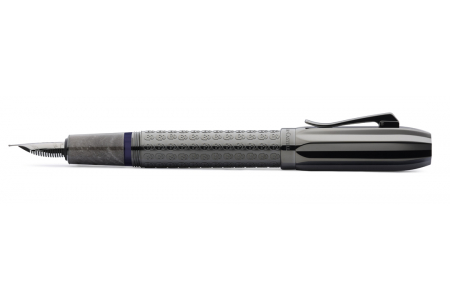Description
Every year we celebrate a special instrument in the Graf von Faber-Castell Collection: the Pen of the Year. As you know, each edition tells stories of eras and peoples whose deeds have changed the history of humanity.
The Pen of the Year 2022 draws inspiration from the culture, aesthetics and religious rites of the Aztecs. The Aztec gods and symbols and numerous prophecies from this period inspire the Pen of the Year 2022
The myth of the Stone of the Five Suns guides us in the realization of the Pen of the Year design. The myth divides the cosmic era into five epochs: the Jaguar Sun, the Wind Sun, the Rain Sun, the Water Sun and - our present world - the Earthquake Sun.
In 1428, three city-states concluded the Aztec Triple Alliance in the territory of today's Mexico. It was so that the foundations were laid for what would later become the mighty Aztec empire that still holds great fascination today.
Volcanic and crystalline
We have recreated this intrigue in the design of the Pen of the Year 2022. But how?
The handle of the Pen of the Year 2022 was made with this cold, opaque magmatic rock: obsidian, a stone of volcanic origin that is formed by the rapid cooling of the lava. The Aztec peasant class used this sharp volcanic glass to make swords, points of spear and arrow. In mythology, Tezcatlipoca (TEZ), the god of the north, wears a leather robe of jaguar, an obsidian mirror and a sacrificial black obsidian blade.
The god Tezcatlipoca represents the first era, the Jaguar Sun. The period is characterized from the existence of human giants and the creation of new gods. A fight between the Quetzalcōātl gods and Tezcatlipoca ends the world.
God of the underworld
According to the myth, when the world was created, the gods divided it into heaven, earth and underworld.
Mictlāntēcutli, the god of the underworld, adorns the tip of the Pen of the Year 2022.
The depictions of Mictlāntēcutli portray him as a skull adorned with owl feathers. This image of the god of the dead reflects the beliefs of the Aztecs. The depictions of skeletons came considered a symbol of fertility, health and abundance .. Even today the decorated skulls cover one great importance for Mexican culture, especially on the Day of the Dead. In the Aztec culture the feathers, such as those of owls, hummingbirds and parrots, had a higher value than gold. The engraved turquoise embedded in the terminal symbolizes the god of the underworld, with power and aesthetics associated with him.
In the second solar cycle, dominated by Quetzalcōātl (QUE), the earth was populated by humans poorly civilized, who had even stopped paying homage to their gods. Indignant, the god Tezcatlipoca (TEZ) transformed those animalistic humans into apes.
Temples and sacrifices
The anthracite gray barrel with a diamond-like carbon coating features countless small engraved skulls.
The inspiration for its realization came from the walls found in the Templo Mayor, which were made of rows of skulls. The Aztecs organized ceremonies to offer this human sacrifice to their gods, in particular Tlaloc and Huītzilōpōchtli, both of which have shrines in a pyramid at Templo Mayor in dedicated to them. Even today, "tzompantli" (skull racks) can be found in many historic buildings throughout Central America.
The third cycle, Rain Sun, is ruled by Tlaloc, the god of rain. Outraged that his wife has been seduced by Tezcatlipoca, uses her power to take it out on people. He submits them to the drought and a rain of fire, thus ending the era.
Precious stones and water
For the Aztecs, turquoise, a rare ornamental stone, was one of the most precious treasures.
Small turquoise discs are incorporated into the cap back and into the final end of the barrel of the Pen of the Year 2022.
This blue-green stone was of great importance and was used both as an ornament on masks, knives and shields, both for ritual purposes. The Aztecs attributed turquoise to the god Xiuhtecuhtli (XIU), husband of Chalchiuhtlicue (CHA), the goddess of lakes, rivers and oceans.
The Water Sun era is influenced by Chalchiuhtlicue. The water goddess was concerned about well-being of the Aztecs. However, the insidious Tezcatlipoca deeply offended her by claiming that he simulated the his benevolence out of simple self-interest. Distraught, Chalchiuhtlicue reacted by dropping one rain that lasted 52 years. Thus it was that the fourth solar cycle ended.
Eagle and cactus
Our journey of inspiration ends with the founding of a city by the Aztecs.
According to the prophecy, the Aztecs would find their new homeland where they saw an eagle devouring a snake perched on a cactus. The migration lasted two hundred years before that could see the prophesied image.
The prickly pear that grew on the rock in the middle of the lake is reproduced in a stylized way by fluted cap shape of the Pen of the Year 2022.
The place where, according to prophecy, the Aztec people settled around 1320 is now one of the largest urban conglomerates of the world: Mexico City.
Quetzalcōātl (QUE) - the divine serpent - did not accept the annihilation of his people and in the fifth solar cycle created new people in the afterlife. Their sky was illuminated by the "Sun of the earthquake", Huītzilōpōchtli (HUI). To make the mighty Huītzilōpōchtli (HUI) stronger, the Aztecs fed him with human sacrifices. Myth has it that if humans stopped making sacrifices or fell in disgrace, the fifth sun would turn black and the world would be destroyed by a gigantic earthquake.
A legacy that still lasts
After the Aztecs found the prophesied island in Lake Texcoco, at the behest of Huītzilōpōchtli (HUI) adopted the name Mexica and founded their capital Tenochtitlán, where today stands Città of Mexico. With the Aztec Triple Alliance, in the 15th century they founded the Aztec Empire, which lasted until the conquest by the Spaniards in 1521. Even today the eagle devouring the snake perched on the cactus mentioned in the prophecy stands on the flag of Mexico.
The Pen of the Year was designed as a reflection of the Aztec Empire and its history.
Limited to 125 rollerballs and 375 fountain pens, each one is unique.
Data sheet
- Material
- carbon
- Trim
- ruthenium
- Pieces Produced
- 125
- Year
- 2022







